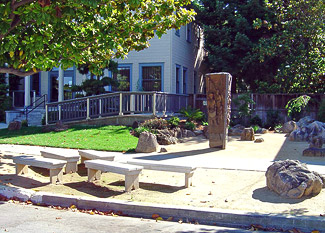| Issei Memorial Building | |
The original building included a doctor’s office, library, and equipment on the first floor with a series of small rooms with patient beds upstairs. An annex in the back of the building provided living quarters for the resident Japanese doctor. The hospital closed its doors in 1934 after the first Japanese doctor received his degree from Stanford, received his license, and began practicing at San Jose Hospital, causing a decline in the demand for Kuwabara’s hospital services. Several community members in Japantown purchased the building for "future generations of Japanese Americans," and turned it into the headquarters of the Nihonjinkai (Japanese Association) although the hospital continued to be used by the medical profession for some time. The hospital has been leased to numerous Japanese American professionals and organizations over the years, and was renamed the Issei Memorial Building after its extensive interior renovation in 1983. It has been designated a San Jose Historic Landmark, and currently houses the San Jose Chapter of the Japanese American Citizens League (JACL), San Jose Taiko offices, and the Contemporary Asian Theater Scene. In 2005, the first Ikoi no Ba (a restful place to rest, reflect and appreciate) was installed at the Issei Memorial Building. The California Japantown Landmark, a permanent outdoor historic exhibit that unifies and tells the history of Japanese American communities in each of the three remaining historic Japantowns in the State of California (San Francisco, San Jose, and Los Angeles), is also installed here. The The three-sided nine-foot tall landmark captures the hopes and struggles of the Japanese American community, and provides the millions of visitors to these Japantowns with the opportunity to learn about and gain a better understanding of the history and challenges of the Japanese American community in California. |
|
 Built in 1910 as the Kuwabara Hospital, this building was originally named for its first resident physician, Dr. Taisuke Kuwabara. Language and religious differences in the early 1900s made it difficult to establish communication and trust between the Japanese Issei and local San Jose doctors, so this hospital was built to entice Dr. Kuwabara to move his practice to Japantown. However, since Japanese doctors could not be legally licensed in the state of California, Dr. Kuwabara’s presence did not fully alleviate this problem. A local doctor, Dr. James Beattie, had to supervise Dr. Kuwabara (and those who later replaced him), perform all surgeries, and even held title to the hospital.
Built in 1910 as the Kuwabara Hospital, this building was originally named for its first resident physician, Dr. Taisuke Kuwabara. Language and religious differences in the early 1900s made it difficult to establish communication and trust between the Japanese Issei and local San Jose doctors, so this hospital was built to entice Dr. Kuwabara to move his practice to Japantown. However, since Japanese doctors could not be legally licensed in the state of California, Dr. Kuwabara’s presence did not fully alleviate this problem. A local doctor, Dr. James Beattie, had to supervise Dr. Kuwabara (and those who later replaced him), perform all surgeries, and even held title to the hospital.